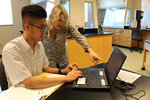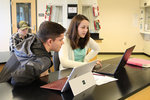

Karen Goodwin may have created Centralia College Capstone Project Day as a way to support her chemistry students in their future scientific endeavors but there is one thing she is adamant about.
“This is not a science fair,” she said.
Capstone Project Day, for Goodwin, is a way for students of all disciplines to show what they have learned and for students, faculty, administrators and the community at large to witness the learning that goes on at Centralia College.
“Anywhere there is a student on this campus using all of the knowledge they have gathered to create something that shows what they have learned, that’s a Capstone project,” Goodwin said.
When she came to Centralia College seven years ago, she said she found there were few well-developed labs for her students to use. So, she decided to task her students with focusing their entire spring quarter on a project-based lab that would be presented in poster form at the end of the year. Goodwin said the experiment not only gave her some help but was a practical exercise for her students, who were preparing for various science-based course of study for which they would need the skill.
“The way scientists usually present their labs is through posters so I thought I’d have them do posters,” Goodwin explained. “Then I thought it would be nice if someone else other than me saw them. That’s how Capstone Project Day was born.”
Goodwin said she invited other Centralia College faculty not only to visit Capstone Project Day but also to consider having some of their students present their own research. The first Capstone Project Day encompassed six projects.
“It’s just a chance for me as a faculty member to get outside my little realm of science and for my students a safe arena to show what they have learned,” Goodwin said. “And it really allows the community to hold us accountable to what we say we’re doing here.”
Last year was Capstone’s largest year ever with 42 projects presented. At this year’s Capstone Project Day, taking place June 7 in the TransAlta Commons, about 40 student projects will be presented. Centralia College nursing students will present topics including: preventing concussions in youth sports; vaping; teen suicide; unexpected infant death syndrome; and teen pregnancy prevention. English 102 students will present research including: “The Big Gamble: Should the Chehalis Tribe Risk Legalizing Marijuana?”; “Clean Needle Programs Save Lives”; “Why Japan Should Not Resume Commercial Whaling in July 2019”; and “Hatchery? Or Extinction?” A project focusing on native salmon species in the Northwest. Information Technology and robotics and engineering projects will include: an automated greenhouse; a medical information organizer; a robotic owl that can be used to scare birds away; a flying simulator; a way to charge an external power supply during a power outage using a sink; and an automated system for a Volkswagen bug. Some projects even have a bit of a humorous side such as a role-player game called “WAYSA: What Are You Staring At?” which contains satire about politics and misinformation and a “Cat Butler” that uses remote sensors to alert cat owners when their feline friend wants to be let into the house.
For the last five years, Capstone projects have also included one more layer of learning experiences for students. Goodwin said she noticed a few years into Capstone that some of the students’ projects required costly materials over and above what is considered a normal lab fee. She approached the Centralia College Foundation about assisting students and $10,000 in grants are offered each year for which students can apply. In the first year, 11 projects received some sort of funding from the Foundation. Last year, 17 projects received funding from the Foundation. Goodwin said students are also encouraged to make requests outside the campus for donations to assist their projects. This, also, is part of the academic process, she noted.
“These grant writing skills are super important to know,” Goodwin said. “How do you talk about something you have deep knowledge about to somebody who has money but does not have deep knowledge of your subject? How do you pitch it? How do you make them want to give you money without burying them in details?”
On a recent afternoon in Goodwin’s chemistry lab, making potentially inaccessible scientific information feel approachable was the order of the day as students worked to put the finishing touches on their Capstone Project Day posters. Students Laitan Richmond-Jordan and Elizabeth Hill proofread each other’s projects. Richmond-Jordan had worked on an experiment on a greener way to synthesize Nylon 66, while Hill had created a lab that would help future students understand the use of a new piece of lab equipment. They both said Capstone Project day would be their first time presenting in this fashion but that they were feeling prepared for the challenge.
“It’s a lot more work but it’s also a lot more energizing,” Richmond-Jordan said of the experience. “I feel a lot more confident now that I’m almost done than when I started.”
Student Tim Soverns, who was recently accepted into the University of Washington pharmacy program, said being able to explain his science, not only to peers but to the public, is one skill that he said he used when applying to pharmaceutical programs and anticipated he would continue to need to use. For his Capstone Project, he created a certain compound from another compound that required a two-step reaction. He explained that the process is important because the resulting material could be used to create more complex pharmaceuticals.
“With the support of Professor Goodwin, I’m really confident to share this with no problem,” he said.